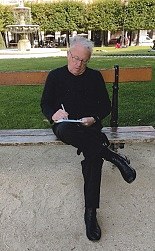
boggdown@aol.com
I returned to my love of drawing, a fundamental professional tool for many years, after retiring from 40 years as a practicing architect, Creating drawings using a variety of readily available felt tipped pens, markers and color pencils, on paper ranging in size from 8” x 10” to 30” x 40”, I developed a highly personal style using short repeated lines in response to the pen point's wear, the irregularity of the watercolor paper surface or the texture of a smooth surface.
Drawings
are based on on-site sketches or on my own photographs of landscapes,
objects or structures, as well as of imagined abstract forms. I use
closely spaced lines, juxtaposed, superimposed, and repeated to
create complex forms with contrasting light and shaded areas develop
by overlapping multiple layers of increasing density within each
drawing. Light, shade and shadow create the gradually emerging three
dimensional space, defined by the limits of the paper surface.
Creating a series of related drawings enables me to concentrate on
the essential qualities of balance, spatial depth and contrast.
Recent work explores multiple drawings to be viewed together and physically connected at an angle, perpendicular or in opposition to each other; a format based on oil on canvas paintings done in earlier years. In architecture, the movement of people through the space and structure is an essential component, and in my drawings I explore how a viewer's movement changes perception when confronted with a static two-dimensional image. The relationship of individual surfaces, joined, in opposition, or in different planes, engages the viewer in perceiving and enjoying the pleasure and mysteries of what are essentially lines on paper.
As a practicing architect, drawing had always been an essential means to create an actual building from the initial concept, and in my professional work I fully utilized computer aided design (CAD) as the primary tool to understanding and defining the construction of complex architectural space. However, drawing by hand can provide a sense of volume, depth, and human presence within the imagined space greater than the mechanical use of the computer.
Being able to visually describe a physical entity through simple but suggestive lines was a powerful way to connect with the client. In my drawings, I want to achieve the same goal of connecting with the viewer. Unlike “architectural” drawing, the drawing itself is the ultimate object, rather than a mere description of another object or form.